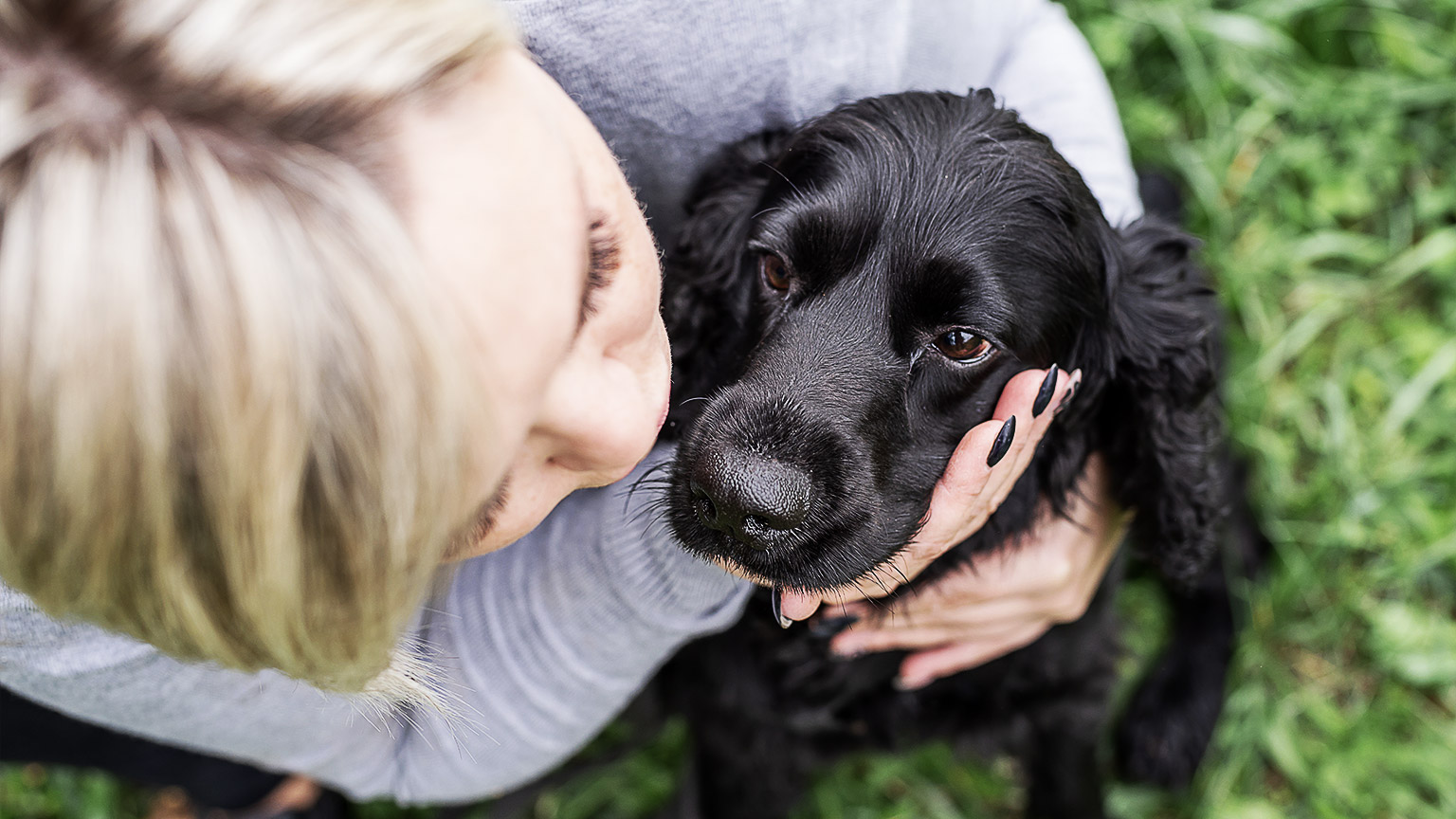While working in a veterinary clinic or animal care facility, you will be required to participate in the development and the opportunity to implement long-term strategies to manage the undesirable behaviour of animals within those facilities.
An enrichment program for animals involves providing activities, environments, or stimuli that enhance an animal’s physical, mental, and emotional well-being. Enrichment helps to mimic the challenges and stimulation animals would naturally encounter in the wild or a more varied environment. It encourages natural behaviours such as foraging, hunting, exploring, and socializing, helping prevent boredom, frustration, and abnormal behaviours, especially in animals kept in captivity, such as in zoos, shelters, boarding facilities, or homes.
Goals of Enrichment Programs
- Promote Natural Behaviours: Encourage behaviours that animals would normally display in the wild, such as foraging, hunting, or exploring.
- Prevent Boredom: Provide stimulation to reduce boredom, frustration, and stress, which can lead to abnormal behaviours.
- Improve Physical Health: Keep animals physically active to maintain their health and well-being.
- Enhance Mental Stimulation: Challenge animals mentally to prevent cognitive decline and encourage problem-solving.
- Increase Animal Welfare: Create a more fulfilling and positive environment for the animals, improving their overall quality of life.
Types of Enrichment
1. Food-Based Enrichment
- This type of enrichment involves using food creatively to engage the animal's natural foraging or hunting instincts.
- Examples:
- Puzzle Feeders: Containers or toys that release food slowly, encouraging the animal to work for it.
- Scattering Food: Spreading food in an enclosure or outside space, requiring the animal to search and forage for it.
- Hiding Treats: Hiding food items in different places to stimulate exploration and hunting behaviours.
2. Sensory Enrichment
- Sensory enrichment targets an animal’s senses—sight, sound, smell, taste, and touch—to provide mental stimulation.
- Examples:
- New Scents: Introducing new smells, such as herbs, spices, or scents from other animals.
- Sound Enrichment: Playing nature sounds, music, or recordings of animal calls.
- Visual Enrichment: Providing visual stimuli like mirrors, videos, or moving objects.
3. Physical/Structural Enrichment
- Physical enrichment includes modifying or adding elements to an animal’s environment to encourage exploration, movement, and play.
- Examples:
- Climbing Structures: Platforms, branches, or shelves that allow animals to climb and jump.
- Tunnels and Hiding Spots: Creating places where animals can hide, rest, or move through, mimicking their natural habitats.
- Water Features: Adding ponds, pools, or water sprays for animals that enjoy swimming or playing in water.
4. Social Enrichment
- Social enrichment involves facilitating interaction with other animals or humans to enhance an animal’s social experience.
- Examples:
- Group Housing: For social species, providing opportunities for interaction with others of their kind.
- Human Interaction: For domesticated animals, regular and positive interaction with caregivers or trainers (e.g., petting, playing).
- Animal Companions: Introducing companion animals to provide social interaction in species that benefit from it (e.g., dogs, parrots).
5. Cognitive Enrichment
- Cognitive enrichment challenges an animal's mind, encouraging problem-solving, learning, and memory exercises.
- Examples:
- Training: Using positive reinforcement techniques to teach animals new tasks or behaviours.
- Puzzles: Providing complex toys or puzzles that require the animal to figure out how to access a reward.
- Games: Interactive games like hide-and-seek or fetch that stimulate mental and physical engagement.
6. Occupational Enrichment
- Occupational enrichment involves giving animals tasks or activities that mimic the jobs they might have in the wild.
- Examples:
- Foraging: Making animals "work" for their food by searching for it or extracting it from containers.
- Problem Solving: Providing challenges that require problem-solving to obtain rewards.
Examples of Enrichment Programs from different settings

1. Zoos and Wildlife Sanctuaries
- Purpose: Encourage natural behaviours that would be seen in the wild and keep animals physically and mentally engaged.
- Examples:
- Giving big cats large balls to simulate prey play.
- Hiding food around enclosures to promote foraging in primates or bears.
- Providing scent trails for wolves or big cats to follow.
2. Animal Shelters
- Purpose: Reduce stress and prevent boredom in animals awaiting adoption.
- Examples:
- Giving dogs interactive toys, like Kong toys stuffed with treats, to keep them mentally engaged.
- Playing music or sounds that calm anxious animals.
- Socialising animals with volunteers to improve their human interaction skills.
3. Boarding Facilities and Daycare Centers
- Purpose: Keep animals entertained and active while they are away from their owners.
- Examples:
- Group play sessions with other animals to provide social interaction.
- Agility courses or obstacle challenges for dogs to exercise and have fun.
- Rotating toys or providing food puzzles for mental stimulation.
4. Domestic Pets (Home Environment)
- Purpose: Keep pets happy, healthy, and mentally stimulated domestically.
- Examples:
- Creating an indoor "cat jungle" with climbing structures and scratching posts.
- Introducing new toys or puzzle feeders to engage a dog’s brain during meal times.
- Allowing supervised outdoor time for rabbits or guinea pigs to explore and forage.
Watch
The next couple of videos are examples of different animal care settings providing examples of animal enrichment programs.
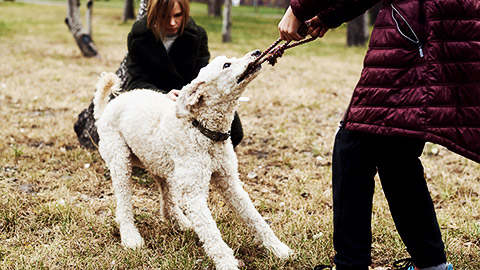
Managing undesirable behaviours in animals requires a good understanding of animal behaviour, patience, and applying the right strategies. Below are some common approaches used to manage these behaviours across various animal care settings:
| Definition | Application | Example | |
| Positive Reinforcement | Rewarding the animal when it shows desirable behaviour to encourage its repetition. | Use treats, praise, or toys when the animal responds correctly, reinforcing your desired behaviour. | If a dog barks excessively, reward it when it stays quiet or follows a “quiet” command. |
| Negative Reinforcement | Removing an unpleasant stimulus when the desired behaviour is shown. | Apply a mild negative stimulus (not punishment) when the animal displays unwanted behaviour and remove it when they behaves correctly. | Light pressure on a leash that is released when the dog stops pulling. |
| Redirection | Distracting the animal and redirecting its focus to a more desirable behaviour. | When an animal engages in unwanted behaviour, divert their attention to something more appropriate. | If a cat scratches the furniture, redirect it to a scratching post. |
| Consistency in Commands | Using the same verbal or physical cues every time to communicate what is expected from the animal. | Stick to consistent commands and routines to prevent confusion, helping the animal understand boundaries. | If you're teaching a dog to “sit,” always use the same word or hand signal and reward when successful. |
| Environmental Modification | Altering the environment to prevent undesirable behaviours or encourage more desirable behaviours. | Adjust the surroundings to make it easier for the animal to succeed. | If a horse tends to kick its stall door, add padding to reduce the impact or change its environment to reduce stress. |
| Training and Socialisation | Gradually exposing the animal to different environments, people, and other animals to encourage calm behaviour. | Regular, controlled exposure helps reduce fear or aggression, leading to better behaviour. | Socialising a puppy with other dogs to prevent aggressive behaviour as it grows. |
| Avoid Reinforcing Undesirable Behaviours | Ensuring unwanted behaviours are not unintentionally reinforced. | Don’t give attention (positive or negative) to undesirable behaviours, as this can sometimes reinforce them. | If a bird screeches for attention, ignoring it until it’s calm and quiet rewards the right behaviour. |
| Use of Time-Outs | Temporarily removing the animal from a stimulating or rewarding environment when it misbehaves. | Time-outs should be short and not used as a punishment but as a way to break the behaviour cycle. | If a dog jumps on people, briefly placing it in a quiet room or kennel can help it understand that jumping leads to isolation. |
| Desensitisation and Counterconditioning | Gradually expose the animal to a stimulus that triggers undesirable behaviour while rewarding calm behaviour to reduce the negative response. | Slowly introduce the animal to the stimulus while ensuring they remain calm and are rewarded. | If a dog is afraid of the vacuum cleaner, start by rewarding it when the vacuum is present but turned off, and gradually progress to when it’s turned on. |
| Establishing Clear Boundaries and Structure | Animals thrive when they understand their role within a structured environment. | Set clear rules and limits and stick to them to create predictability and reduce anxiety. | For a horse that tries to bite while being saddled, establish a clear process and expectations during saddling and reward compliance. |
| Seeking Professional Help When Necessary | In cases of severe behaviour issues, consult with a behaviourist or a trainer specialised in that species. | A professional can create a tailored behaviour modification plan and offer guidance for more persistent issues. | A certified dog behaviourist can help address aggressive behaviours requiring specialised intervention. |
Watch
The next video is a quick tutorial explaining how to stop puppies from biting and strategies to use to work with this.
There are several areas in the management and strategy of dealing with those undesirable behaviours. Strategies to encourage natural behaviour may include:
- Consulting behaviour specialists for:
- Behaviour modification of animal
- Training for owner or handler
- Food or food-related enrichment to encourage foraging and hunting may be provided by:
- Giving animals opportunities to hunt or forage for food by hiding it in substrates
- Giving the animal food that requires processing (e.g. Peeling or shelling fruit or seeds)
- Gnawing manipulada (manipulation)
- Providing equipment to encourage appropriate exercise:
- Access to larger areas for free exercise or lead walking
- Climbing poles and scratching posts
- Ladders, ropes and treadmills
- Providing equipment and toys for skill development and time occupiers:
- Non-edible items that can be easily added or removed from the environment, such as toys (e.g. Balls, bells, toys, puzzles and mirrors)
- Providing species-appropriate housing and bedding:
- Hide boxes, tunnels and ladders
- Nest building or bedding material:
- Shredded paper
- Straw
- Substrate
- Wood shavings
- Perches, roosting shelves and nest boxes
- Social enrichment:
- Levels of contact with other animals of the same species or breed
- Social interactions between the animal and the carer may also be appropriate
Any strategies and or management must be done by your clinic/facility policies and procedures as well as in consultation with the supervisor, manager or business owner.
Case Study

Scenario: Addressing Undesirable Barking in a Shelter Dog
At Happy Paws Animal Care, a young dog named Buddy, a two-year-old Labrador mix exhibited excessive barking in his kennel. His barking was constant whenever people passed by, which made it difficult for the staff to manage the environment and for potential adopters to engage with him. The behaviour was likely linked to anxiety and overstimulation due to the shelter environment.
Strategy to Manage Undesirable Behaviour:
- Identifying the Cause: The staff observed Buddy's behaviour and determined that his barking was triggered by overstimulation from people walking by his kennel, as well as frustration from not receiving attention.
- Reducing Stimuli: To help reduce Buddy's overstimulation, the team implemented the strategy of covering his kennel with a blanket to limit visual stimuli. This helped reduce the number of triggers that led to his barking, creating a calmer environment.
- Positive Reinforcement: The staff used positive reinforcement to encourage calm behaviour. Whenever Buddy remained quiet and relaxed, he was rewarded with treats or verbal praise. This reinforced the idea that calmness, rather than barking, earned him rewards.
- Increased Physical and Mental Stimulation: Since Buddy's barking was also linked to excess energy, he was given more opportunities for physical exercise and mental stimulation. The staff increased his daily walks and provided him with puzzle feeders to keep him engaged and reduce frustration in his kennel.
Outcome:
After two weeks of consistent reinforcement, Buddy’s barking significantly decreased. He learned that calm behaviour led to positive outcomes and that reduced visual stimuli helped him relax. As a result, Buddy became more approachable, and his chances of being adopted improved.
This case study highlights the importance of identifying the triggers of undesirable behaviour and implementing a combination of environmental modifications, positive reinforcement, and appropriate mental and physical stimulation.
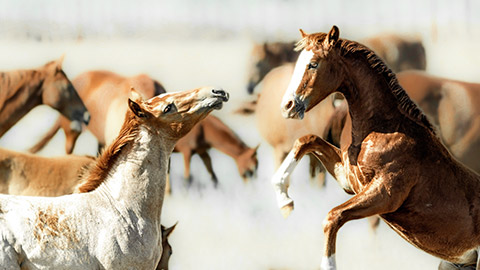
There may be, in some circumstances, a requirement for short-term management of animals that are exhibiting undesirable behaviour; this may be in a circumstance where the animal is malnourished and showing signs of stress as well as fear.
Then you may have to use a short-term strategy such as:
- Providing the animal with food that will assist in the recovery of the animal
- Providing the animal shelter:
- Shelter from the element
- Shelter and security whilst they are eating
No matter what strategy is being conducted, it must be conducted according to the facility's policies and procedures and as directed. You must also make sure that you make a concise note of the effect of the strategy.
Recognising signs of stress and malnutrition in animals is crucial for their well-being, particularly in animal care settings. Below are common signs and symptoms of each condition:
Signs and Symptoms of Stress in Animals
Changes in Behaviour
- Aggression, growling, biting, or hissing
- Withdrawal or avoidance of people and other animals
- Increased vocalisation (e.g., barking, meowing, or whining)
- Excessive grooming or self-mutilation (e.g., licking paws or chewing skin)
- Pacing, circling, or repetitive movements (common in confined animals)
Physical Changes
- Dilated pupils or wide-eyed appearance
- Excessive shedding or fur loss
- Sweating (especially in horses)
- Trembling or shaking
- Panting (in dogs and other mammals)
Altered eating and drinking habits
- Dilated pupils or wide-eyed appearance
- Excessive shedding or fur loss
- Sweating (especially in horses)
- Trembling or shaking
- Panting (in dogs and other mammals)
Altered eating and drinking habits
- Refusal to eat or drink
- Overeating or drinking excessively
- Rapid weight loss or gain
Changes in the elimination habits
- Frequent urination or defecation
- Urinating or defecating in inappropriate places
- Diarrhoea or constipation
Posture and Body Language
- Tail tucked between the legs (in dogs) or tail flicking (in cats and horses)
- Cowering or hunched body posture
- Ears pinned back or flattened
Respiratory and Heart Changes
- Rapid breathing or panting
- Increased heart rate
Social Signs
- Avoid interaction with familiar people or other animals
- Overexcitement when approached
- Unusual clinginess or the opposite: being distant
Signs and Symptoms of Malnourishment in Animals
Weight Loss
- Visible ribs, spine, and hip bones
- Thin, gaunt appearance
- Lack of muscle tone
Poor Coat Condition
- Dull, dry, or brittle fur
- Fur loss or patches of baldness
- Flaky or irritated skin
- Slow hair or fur growth
Lethargy and Weakness
- Decreased energy levels or reluctance to move
- Sleeping more than usual
- Difficulty standing or walking
Gastrointestinal Issues
- Vomiting or diarrhoea
- Constipation
- Poor appetite or refusal to eat
Poor Immune Function
- Frequent infections or illnesses
- Slow healing of wounds
- Chronic respiratory issues (e.g., coughing or sneezing)
Behavioural Changes
- Irritability or aggression
- Depression or lack of interest in surroundings
- Increased anxiety or nervousness
Dental Issues
- In species that chew, such as rodents or grazing animals, worn-down teeth can indicate a lack of appropriate food.
- Difficulty eating or chewing food
Other Physical Symptoms
- Weakness in limbs, difficulty moving, or staggering
- Pale gums or mucous membranes (may indicate anaemia)
- Bloating or signs of fluid retention in the abdomen
Delayed growth in young animals
- Stunted growth or failure to thrive
- Poor muscle development
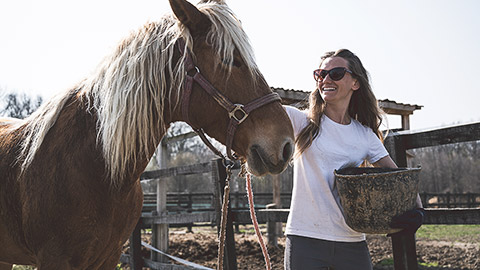
When preparing and implementing enrichment programs, you need to make sure you comply with animal welfare and health and safety requirements.
Safe and humane animal handling techniques
When handling and conducting behavioural management processes, it is extremely important that you observe the health safety requirement as per the state and/or territory Health and Safety legislation, as well as your facility policies and procedures on health and safety.
Remember some of the key considerations with Safe and Humane Handling techniques include the following:
- Understanding animal behavior
- Approaching the animal calmly
- Using proper restraint techniques
- Avoiding stressful situations
- Humane use of tool and equipment
- Use of positive reinforcement
- Safe lifting techniques
- Safe handling of reptiles
- Handling aggressive or fearful animals
- Avoiding punishment.
Following the health and safety requirements will not only look after your own health and safety as well as that of other staff and visitors to the facility but will also consider the animals' health and welfare in your facility.
Workplace policies and procedures relevant to providing enrichment to animals, including health and safety and animal welfare
Providing enrichment to animals in a workplace setting is crucial for their physical and mental well-being. To ensure that enrichment activities are safe and effective, it’s important to follow workplace policies and procedures. These typically cover aspects such as health and safety, animal welfare, and legal requirements. Here’s an overview of key policies and procedures relevant to providing enrichment to animals:
- Animal Welfare Policies
- Health and Safety Policies
- Standard Operating Procedures (SOPs) for Enrichment Activities
- Behavioural Observation and Reporting
- Legal and Regulatory Compliance
- Emergency Procedures
- Training and Competency
- Animal-Specific Enrichment Policies
Workplace policies and procedures, animal welfare, and WHS requirements may include:
- Animal welfare requirements:
- Compliance with appropriate state or territory legislation and regulations
- Keeping health and behaviour records
- Providing adequate housing and stock levels
- Providing appropriate enrichment opportunities
- The absence of pests and vermin
- The compatibility of species and breeds
- WHS requirements:
- Use of relevant personal protective equipment, such as animal handling gauntlets and eyewear
- Hazard identification, risk minimisation and workplace procedures for:
- Animal bites, kicks, scratches, crush injuries
- Biological hazardous waste and sharps disposal
- Gas leakage
- Handling, use, storage, transport and disposal of chemicals and medicines
- Inhalation of aerosol particles
- Manual handling, including carrying, lifting and shifting
- Needle pricks and cuts from other sharps
- To control the release of infective agents (animal and human)
- Transmission of zoonotic diseases
When handling any animal, it is crucial to follow your workplace hygiene standards to ensure the health and safety of both the animals and the handlers. Proper hygiene practices help prevent the spread of diseases, infections, and parasites and maintain a clean environment for everyone involved. Below are some important considerations for maintaining workplace hygiene when handling animals:
Key Considerations we have addressed before include:
- Cleaning agents
- Cleaning techniques
- Cleaning equipment and materials.
It is important that you treat all animals using the principles of animal welfare and ethics, which are taken from the AVA code of professional conduct.
The community and your clients are entitled to expect that you will:
- Always consider the health and welfare of the animal, and treat it respectfully.
- Take personal responsibility to uphold the good reputation and integrity of the profession.
- Strive to provide the best possible services and improve the quality of animal health and welfare at every opportunity.
- Foster and maintain good communications and relationships with your clients, earning their trust and respecting client confidentiality.
- Understand and comply with all relevant laws and guidelines, especially those regarding animal welfare, veterinary certification and the prescribing of restricted substances.
- Foster and endeavour to strengthen relationships with your professional colleagues, utilising their skills where appropriate.
- Maintain and continue to enhance your professional knowledge and skills.
- Wherever possible, adhere to AVA policies and guidelines.
What are some examples of zoonotic diseases?
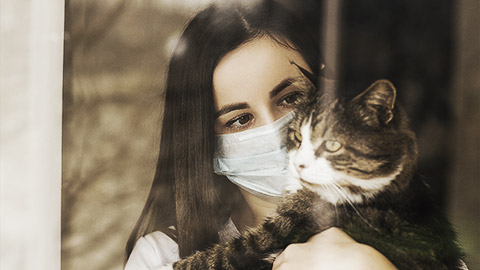
Zoonotic diseases are infectious diseases that can pass from animals to humans. Seventy-five per cent of new human diseases are zoonotic.
Some zoonotic diseases, such as hydatids, anthrax, Hendra virus infection, avian influenza or rabies, are potentially very serious in humans and can cause fatalities.
It is important that people who handle animals, and people like vets who treat sick animals, are very aware of the risk of zoonotic diseases.
If there is a known risk, people should take active steps to reduce the risk, e.g. by avoiding or minimising contact with potentially infective animals or by using effective personal protective equipment (PPE) when handling such animals or their products.
The list of types of Zoonotic Diseases mentioned in various sources includes:
- Insect-borne diseases
- Mosquito-borne diseases
- Tick-borne diseases
- Rodent-borne diseases
- Flea-borne diseases
- Louse-borne diseases
- Mite conditions
- Lice conditions
- Dog bite
- Cat bite
- Toxoplasmosis - often caught from cat faeces
- Australia bat lyssavirus
- Anthrax
- Babesiosis
- Brucellosis
- Cat scratch disease
- Giardiasis
- Histoplasmosis (Very rare in Australia)
- Listeriosis
- Psittacosis
- Q fever
- Salmonellosis
- Toxocariasis
- Hydatid disease
- Leptospirosis
- Eastern equine encephalitis
- Western equine encephalitis
As you can see from the list above, there are a large number of diseases that can be caught from animals; therefore, it is vitally important that you follow health and safety when handling the animals at all times.
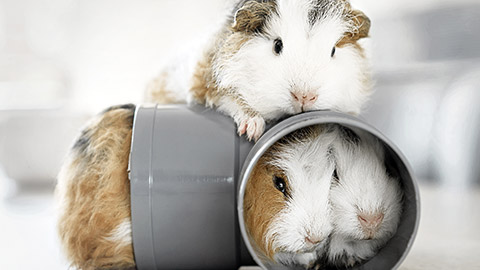
Enrichment programs are designed to provide mental and physical stimulation to animals, encouraging natural behaviours and enhancing their overall well-being. Different species require tailored enrichment to meet their specific needs. Here are examples of enrichment programs for various types of animals:
Dogs
- Physical Exercise: Dogs benefit from regular walks, play sessions with toys like balls or frisbees, and agility courses that challenge their physical capabilities.
- Mental Stimulation: Puzzle toys or treat-dispensing toys keep dogs engaged, requiring them to figure out how to retrieve the treat.
- Social Interaction: Opportunities to interact with other dogs or humans, such as playgroups or one-on-one attention, can provide valuable social enrichment.
- Scent Work: Hide treats or toys for dogs to sniff out, allowing them to engage their natural hunting instincts.
Cats
- Interactive Toys: Cats enjoy toys that mimic prey, such as feather wands, laser pointers, or balls that move unpredictably. These help engage their hunting instincts.
- Climbing and Scratching Structures: Cat trees, shelves, and scratching posts encourage climbing and scratching, behaviours that cats naturally engage in.
- Hide and Seek: Provide hiding spots, such as boxes or tunnels, where cats can feel secure while engaging in their exploratory behaviour.
- Puzzle Feeders: Cats can benefit from puzzle feeders that make them work for their food, engaging their mental skills and natural hunting behaviours.
Birds (Parrots, Cockatoos)
- Foraging Activities: Birds like parrots enjoy finding food hidden in toys or within layers of paper. This mimics natural foraging behaviour.
- Varied Perching Options: Provide a range of perches at different heights and textures to keep birds physically active.
- Social Interaction: Many bird species are highly social, so regular interaction with humans or other birds is essential. Talking, playing with toys, or learning new tricks offers mental enrichment.
- Shreddable Toys: Birds enjoy shredding paper, cardboard, or wood, which satisfies their need to chew and manipulate objects.
Small Mammals (Rabbits, Guinea Pigs)
- Burrowing and Digging Opportunities: Provide substrates like hay, straw, or paper for rabbits and guinea pigs to dig and nest in, encouraging natural burrowing behaviours.
- Tunnels and Hideouts: Tunnels, mazes, and shelters encourage exploration and give them a sense of security.
- Chew Toys: Safe chew toys made of wood or other materials help small mammals wear down their teeth and stay engaged.
- Social Enrichment: Many small mammals, such as guinea pigs, thrive with social interaction from both humans and other animals, especially within their species.
Horses
- Environmental Enrichment: Horses benefit from large paddocks where they can graze, move freely, and engage in natural foraging behaviour.
- Toys and Balls: Large horse balls or hanging toys in the stable can keep horses entertained, preventing boredom.
- Foraging Devices: Slow feeders or hay nets encourage horses to eat more slowly and engage in natural grazing behaviours.
- Training and Play: Training sessions, trail rides, or even liberty play (where horses interact freely with their handler) can stimulate horses both mentally and physically.
Reptiles (Snakes, Lizards, Turtles)
- Climbing Structures: For lizards, providing branches, rocks, or platforms encourages climbing and basking, behaviours they would engage in naturally.
- Burrowing Substrates: For species that like to burrow, such as certain snakes or turtles, provide loose substrates like sand or soil to allow them to dig.
- Feeding Enrichment: Live prey (for species that eat live food) or hidden food items encourage reptiles to engage in natural hunting behaviours.
- Temperature Gradients: Creating temperature zones within their enclosure allows reptiles to thermoregulate, which is critical for their health and natural behaviour.
Farm Animals (Pigs, Goats, Cows, Sheep)
- Pigs: Pigs are intelligent animals that enjoy rooting and foraging. Enrichment can include hiding food in straw or dirt, puzzle feeders, and balls or toys to push around.
- Goats: Goats love to climb and explore, so providing structures like ramps, platforms, or rocks for them to climb engages their natural curiosity.
- Cows: Environmental enrichment for cows includes rotating grazing areas, providing scratching posts, and offering access to varied terrain to promote movement and exploration.
- Sheep: Sheep enjoy foraging and grazing, so varying their pasture, offering different grasses, and allowing social interaction with the flock are important enrichment activities.
Aquatic Animals (Fish, Turtles, Marine Mammals)
- Fish: Fish can be enriched with various tank decorations, plants, and hiding places that mimic their natural environment. Changing the layout of the tank periodically keeps it engaging for the fish.
- Turtles: Aquatic turtles benefit from basking platforms, varied water depths, and places to explore both underwater and on land. Enrichment can also include live prey, like small fish, for them to catch.
- Dolphins or Seals: Marine mammals thrive on cognitive enrichment like problem-solving games, training sessions that reward them for performing tasks, and social interaction with both humans and other animals.
Wildlife Sanctuary
- Kangaroos and Wallabies: Provide open spaces for natural foraging, along with access to shrubs and trees to replicate their native habitat.
- Birds of Prey: For eagles or owls, enrichment might include flight training, feeding them in ways that replicate hunting (like using lure systems), and providing large spaces to fly and perch.
- Koalas: Koalas benefit from enrichment miming their natural environment, such as fresh eucalyptus branches for feeding and climbing.
Zoo Animals (Big Cats, Primates, Elephants)
- Big Cats (Lions, Tigers): Enrichment can include food puzzles, scent trails, and objects to chase or pounce on, mimicking hunting behaviour.
- Elephants: Large logs or tyres to push around, pools for bathing, and food hidden in complex feeders can provide physical and mental stimulation.
- Primates (Chimpanzees, Gorillas): These highly intelligent animals benefit from social interaction, tool use, problem-solving games, and foraging activities that challenge their cognitive abilities.
Watch
Below are some videos providing examples of Enrichment Activities.
Case Study
Happy Paws Animal Care is implementing new enrichment programs to support the physical, mental, and emotional well-being of its animals. Staff need to ensure these activities are conducted in ways that minimise stress and use safe handling techniques appropriate to each species. Here are some examples:
Dog (Animal Shelter Setting) |
Enrichment Activity: Scent games using hidden treats Handling Technique:
|
Cat (Animal Boarding Facility) |
Enrichment Activity: Puzzle feeders to stimulate natural hunting instincts Handling Technique:
|
Horse (Equine Therapy Centre) |
Enrichment Activity: Groundwork activities like navigating poles Handling Technique:
|
Snake (Reptile Park) |
Enrichment Activity: Scent trails to encourage natural foraging behaviour Handling Technique:
|
Cow (Dairy Farm) |
Enrichment Activity: Brushing stations or scratching posts Handling Technique:
|
Sheep (Petting Farm) |
Enrichment Activity: Introduce safe, novel objects to investigate, like a hanging ball Handling Technique:
|
Rabbit (Animal Shelter Setting) |
Enrichment Activity: Tunnel maze for hiding and exploring Handling Technique:
|
Lizard (Reptile Sanctuary) |
Enrichment Activity: Climbing structures and branches for exploration Handling Technique:
|
Bird (Aviary) |
Enrichment Activity: Foraging activities with seed balls or leafy branches Handling Technique:
|
Each technique is designed to support safe, humane, and low-stress enrichment by considering the specific needs and behaviours of each animal, ensuring they have positive experiences and opportunities to engage naturally.

Encourage Natural Behaviour: Rest, Hiding, and Shelter in Appropriate Housing
Encouraging animals to engage in natural behaviours like resting, hiding, and seeking shelter is essential for their well-being. These behaviours help reduce stress, promote physical and mental health, and align with animal instincts. Below are strategies and examples of activities and equipment for different types of animals.
Strategies to Encourage Natural Behaviour: Rest, Hiding, and Shelter in Appropriate Housing
Encouraging animals to engage in natural behaviours like resting, hiding, and seeking shelter is essential for their well-being. These behaviours help reduce stress, promote physical and mental health, and align with animal instincts. Below are strategies and examples of activities and equipment for different types of animals.
1. Resting Behaviours
Objective: To provide an environment encouraging animals to rest and sleep in a comfortable, safe space, mirroring their natural habits.
Activities and Equipment
-
Dogs
- Equipment: Soft bedding, blankets, or elevated dog beds.
- Activities: Create quiet, dimly lit resting areas away from busy or noisy parts of the facility. Rotate rest periods to mimic natural activity-rest cycles.
- Natural Behaviour Encouraged: Denning, relaxation in safe spots.
-
Cats
- Equipment: Soft, enclosed beds or hammocks placed in elevated positions (cats prefer high resting spots for safety and observation).
- Activities: Provide multiple resting spots throughout the facility, allowing the cat to choose based on preference.
- Natural Behaviour Encouraged: Seeking warmth and security in elevated, hidden spaces.
-
Reptiles (Snakes and Lizards)
- Equipment: Heat lamps, basking rocks, and cooling areas to help reptiles self-regulate their body temperature.
- Activities: Create temperature gradients with warm and cool zones in their enclosures.
- Natural Behaviour Encouraged: Thermoregulation, resting in heat-retaining spots, and seeking cool areas when needed.
-
Birds
- Equipment: Soft perches of varying widths to support foot comfort and rest. Nesting boxes for species that prefer enclosed spaces.
- Activities: Ensure the perches are located in calm, elevated parts of the enclosure.
- Natural Behaviour Encouraged: Perching, roosting in safe locations, and resting during daylight or night-time cycles.
2. Hiding Behaviours
Objective: To create opportunities for animals to hide or retreat, offering them privacy and a sense of security. Hiding spaces reduces stress, allowing animals to feel safe when needed.
Activities and Equipment
-
Dogs
- Equipment: Crates, covered beds, or enclosed nooks.
- Activities: Dogs can be trained to use their crate or safe space as a retreat when feeling stressed or tired. Crates should be positioned away from high-traffic areas.
- Natural Behaviour Encouraged: Seeking shelter, denning, and privacy.
-
Cats
- Equipment: Cat tunnels, hidey-holes, or cardboard boxes.
- Activities: Set up multiple hiding spots where cats can retreat if they feel overwhelmed. Allow them to hide during stressful events (e.g., vet visits, unfamiliar guests).
- Natural Behaviour Encouraged: Solitude-seeking, hiding from perceived threats, and reducing social interaction when needed.
-
Reptiles (Snakes and Lizards)
- Equipment: Caves, logs, and dense foliage to simulate natural hiding spots.
- Activities: Provide multiple hiding spots in different parts of the enclosure to mimic their natural environment (e.g., hiding under logs or rocks).
- Natural Behaviour Encouraged: Camouflaging, hiding from predators, and avoiding excessive exposure.
-
Birds
- Equipment: Nesting boxes, leafy branches, or screens to create hidden perches.
- Activities: Birds can use these areas for privacy and to rest without being seen by others in the enclosure.
- Natural Behaviour Encouraged: Nesting, hiding from predators or disturbances, and feeling secure in enclosed spaces.
3. Shelter and Security
Objective: To provide structures and spaces that allow animals to feel protected from environmental elements (e.g., wind, rain, heat) and maintain their natural shelter-seeking behaviours.
Activities and Equipment
| Dogs | Cats | Reptiles (Snakes and Lizards) | Birds | |
|---|---|---|---|---|
| Equipment | Dog houses, sheltered runs, or covered outdoor areas. | Sheltered outdoor enclosures (catios), covered platforms, and indoor hiding spaces. | Naturalistic hides like cork bark, rocks, and foliage for coverage. | Sheltered aviary corners, thick branches, or hanging foliage. |
| Activities | Dogs naturally seek out shelter when exposed to harsh weather. Providing them with access to shaded or covered areas encourages this behaviour. | Cats can freely move between sheltered areas and open spaces in enclosures, allowing them to exhibit both hunting and shelter-seeking behaviours. | Reptiles need shelter to regulate body temperature and to feel safe. Use naturalistic shelters that resemble the animal’s native environment (e.g., caves, overhanging rocks). | Position these shelters high in the aviary to allow birds to feel protected from potential predators below. |
| Natural Behaviour Encouraged | Seeking protection from the elements, finding cool or warm areas depending on the weather. | Shelter-seeking during environmental stress, finding warmth, and using secluded spaces for safety. | Seeking shelter during different parts of the day (e.g., basking in the sun or retreating to shade). | Nesting, protection from the elements, and retreating from threats. |
Encouraging natural behaviours like resting, hiding, and seeking shelter ensures animals feel safe and secure in their environment. By providing the right equipment and activities, these instincts can be nurtured, resulting in healthier, more content animals. Proper housing, regular enrichment, and observation of individual preferences are key to supporting natural behaviours across different species.
Encourage Natural Behaviour by Reinforcing the Role of the Owner or Handler

Encouraging natural behaviours while reinforcing the relationship between an animal and its owner or handler is essential for building trust, confidence, and a sense of security. This can be done through specific activities and equipment tailored to the needs of each species. The goal is to ensure that interactions with handlers support the animals’ well-being while fostering positive engagement and respect.
1. Dogs
Natural Behaviour: Dogs are naturally social animals that thrive on structure, leadership, and companionship. Owners and handlers should reinforce these instincts through training and positive reinforcement, helping the dog understand its role within the pack or family unit.
Activities and Equipment
-
Training Sessions (Obedience and Agility)
- Equipment: Treats, clickers, agility courses (hurdles, tunnels), and leashes.
- Activity: Regular training sessions, such as obedience or agility training, reinforce the dog's natural inclination to follow a leader. Handlers use rewards and positive reinforcement to strengthen their bond with the dog, teaching them commands and tasks that mirror their natural behaviours, such as retrieving or herding.
- Natural Behaviour Encouraged: Pack structure, following a leader, working for rewards.
-
Walks and Socialisation
- Equipment: Leash, harness, and treats for positive reinforcement.
- Activity: Taking dogs for daily walks, where they can explore their environment under the guidance of their handler, reinforces their natural need for exercise, mental stimulation, and social interaction. Positive reinforcement with treats and verbal praise encourages the dog to follow the handler's lead.
- Natural Behaviour Encouraged: Exploration, social bonding, and pack-oriented activity.
2. Cats
Natural Behaviour: Cats are naturally independent but still bond with their owners. They rely on their instincts for hunting and exploration, and the owner or handler can foster trust through gentle guidance, play, and feeding routines.
Activities and Equipment
-
Interactive Play Sessions
- Equipment: Feather wands, laser pointers, and puzzle feeders.
- Activity: Engaging in interactive play that mimics hunting behaviour helps build trust between cats and their handlers. By guiding the play session and rewarding the cat for engaging in natural behaviours like chasing, stalking, and pouncing, the owner reinforces their role as a provider of mental and physical stimulation.
- Natural Behaviour Encouraged: Hunting, pouncing, and bonding through play.
-
Routine-Based Feeding and Care
- Equipment: Food bowls, treats, and grooming tools.
- Activity: Cats benefit from consistent routines, especially around feeding times. Owners can use this opportunity to reinforce trust by gently grooming the cat and ensuring they have predictable feeding and interaction schedules. These routines mimic the cat’s instinctual preference for order and security in its territory.
- Natural Behaviour Encouraged: Establishing routine, trust-building, and territory management.
3. Birds (Parrots)
Natural Behaviour: Parrots are intelligent, social creatures that naturally live in flocks and engage in complex communication and problem-solving behaviours. Owners and handlers can reinforce these natural tendencies by providing mental stimulation and opportunities for social interaction.
Activities and Equipment
-
Training for Commands and Tricks
- Equipment: Clickers, treats, and perches.
- Activity: Training parrots to follow simple commands like "step up" onto a hand or perch encourages trust and strengthens the bond between the bird and its handler. This training taps into the parrot's social behaviour and needs for interaction while providing mental stimulation.
- Natural Behaviour Encouraged: Socialisation, communication, and following group leadership.
-
Foraging Activities
- Equipment: Foraging toys, puzzle feeders, and shredded paper.
- Activity: Providing enrichment through foraging encourages birds to engage in their natural behaviours of searching for food. The handler can make foraging a shared activity by placing treats in puzzle feeders and interacting with the bird as it engages in enrichment.
- Natural Behaviour Encouraged: Foraging, problem-solving, and social interaction.
4. Reptiles (Snakes)
Natural Behaviour: Snakes are solitary, instinct-driven creatures that rely on routines and predictable environments. While they don't bond with handlers in the same way as dogs or cats, they can learn to associate their handler with positive experiences like feeding.
Activities and Equipment
-
Feeding Routines
- Equipment: Feeding tongs, thawed rodents (for feeding), and a safe feeding space.
- Activity: Snakes should be fed in a consistent, routine-based manner that mirrors their natural hunting cycles. By using feeding tongs and maintaining a routine, handlers help the snake associate their presence with positive experiences. This reduces stress and helps the snake feel secure.
- Natural Behaviour Encouraged: Hunting, feeding, and calm behaviour during human interaction.
-
Gentle Handling
- Equipment: Snake hooks, gloves, and secure holding areas.
- Activity: Handling snakes regularly but gently, using appropriate tools, allows them to become accustomed to human contact without triggering stress or defensive behaviour. Handlers reinforce calm and predictable behaviour.
- Natural Behaviour Encouraged: Exploration and reducing defensive reactions.
5. Horses
Natural Behaviour: Horses are herd animals with strong social structures. They respond well to handlers who display leadership through calm, consistent guidance, similar to the role of a dominant horse in a herd.
Activities and Equipment
-
Groundwork Training (Lunging, Leading)
- Equipment: Lead ropes, halters, and lunge lines.
- Activity: Groundwork helps horses understand their handler's role as a leader in their "herd." By teaching them to walk, trot, and follow commands on the ground, handlers reinforce calm, cooperative behaviour and build trust.
- Natural Behaviour Encouraged: Following herd leadership, responding to cues, and establishing trust.
-
Riding and Positive Reinforcement
- Equipment: Saddles, reins, and grooming kits.
- Activity: During riding sessions, handlers reinforce natural behaviours through calm and steady commands. Positive reinforcement (e.g., verbal praise, treats, grooming) after rides encourages horses to associate the handler with positive experiences.
- Natural Behaviour Encouraged: Cooperation, social bonding, and responding to leadership.
